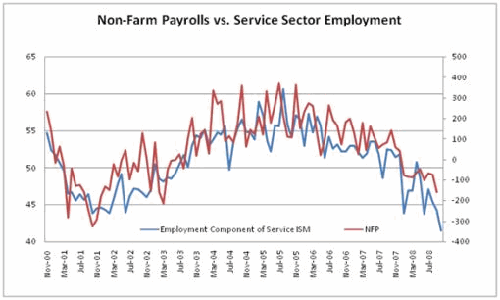| Why October Non-Farm Payrolls Could Fall By 300K |
| By Kathy Lien |
Published
11/6/2008
|
Currency , Futures , Options , Stocks
|
Unrated
|
|
|
|
Why October Non-Farm Payrolls Could Fall By 300K
Even though the US economy has not officially entered a recession, the US labor market has.
October will mark the tenth consecutive month of net job losses. The market currently projects a loss of 200k jobs last month, but given the trend of job losses in past recessions, there is a growing chance that we may finally see job losses top 300k.
There is every reason to believe that the US labor market deteriorated significantly in the month of October. The credit crisis hit a peak, forcing companies to cut back. No one can argue that the US economy is in the worst shape since the Great Depression. Since we have seen a single month job loss of more than 300k in every recession over the past 30 years, there is no reason to believe that this time, it will be different.
However a weak job number may not necessarily be negative for the US dollar if it triggers another wave of risk aversion, forcing investors into the safety of the low yielders.
Impact of Weak NFPs on Currencies
If non-farm payrolls fall more than 250k, it would be initially negative for the US dollar, but when the US stock market opens, we could see the dollar rally. Traders need to remember that the dollar is appreciating not because of the strength of the US economy, but because money flocks into low yielding currencies during a global recession. In a very short period of time, the US dollar has become the second lowest yielding G7 currency.
A weak labor market number will mean two things – more weakness for US equities and another 50bp rate cut from the Federal Reserve next month. By extension, it will lead to weakness in USD/JPY, EUR/USD, GBP/USD and all of the Japanese Yen Crosses. The only way to avoid another round of selling would be if non-farm payrolls dropped by less than 150k.
Arguments for More than 200K Drop in Non-Farm Payrolls
Every month, we take a look at 9 leading indicators for non-farm payrolls and this month, every single one of them points to large job losses. Consumer confidence has hit a record low, layoff announcements and continuing claims hit a 5 year high while the employment components of service and manufacturing both point to continued job losses. Not only are more Americans being laid off, but those who have already lost their jobs are having a very tough time finding new ones. It is rare that we get such a strong signal about the state of the labor market, but the layoff announcements coming from all different sectors of the US economy confirm that we will see large scale job losses.
This is the main reason why US equities have sold off aggressively over the past 48 hours, sending investors into the US dollar and Japanese Yen, the 2 lowest yielding currencies.
Here’s how the 9 leading indicators stack up:
1. Employment Component of Service Sector ISM Dropped to Lowest Level since 1997
2. Employment Component of Manufacturing Sector ISM fell 7.2 Points to 34.6, Index Fall to 26 Year Lows
3. ADP Report Private Sector Job Losses of -157K
4. Challenger Layoffs Up 79%, a 5 Year High
5. Consumer Confidence Falls to Record Low
6. Continuing Claims Reaches 5-year High
7. Average Claims is at 475K, Well Above the Yearly Average of 393K
8. Strike Activity Rises 27K
9. Monster.com Index Hits 3 Year Low
Since the service sector ISM report covers 90 percent of the US economy, it is not surprising that the employment component of the report is a very strong leading indicator of non-farm payrolls. The sharp drop in the employment component of the report signals an equally large decline in non-farm payrolls.

The Upside of Losing 300K Jobs
Of the 77 economists surveyed by Bloomberg, the most optimistic forecast is by Argus Research who calls for only an 85k drop in non-farm payrolls and the most pessimistic is Goldman Sachs, who is calling for a 300k drop. The unemployment rate is expected to jump from 6.1 to 6.3 percent, matching the 5 year high.
Don’t expect the job losses to end in October. In the past 3 recessions, job losses have extended beyond 10 months. The longest stretch of job losses in the past 30 years was between 1980 and 1982, where we saw 17 consecutive months of job losses. With market caps evaporating and lending still frozen, US companies will continue to tighten their belts. A loss of 300k jobs would not be all bad because it would suggest that we are nearing the bottom in the labor market. However if job losses fall short of 300k, it will just be a matter of time before it ends up breaking that level at which time, we will be looking for a bottom in the labor market.

Kathy Lien is Director of Currency Research at GFT, and runs KathyLien.com.
|